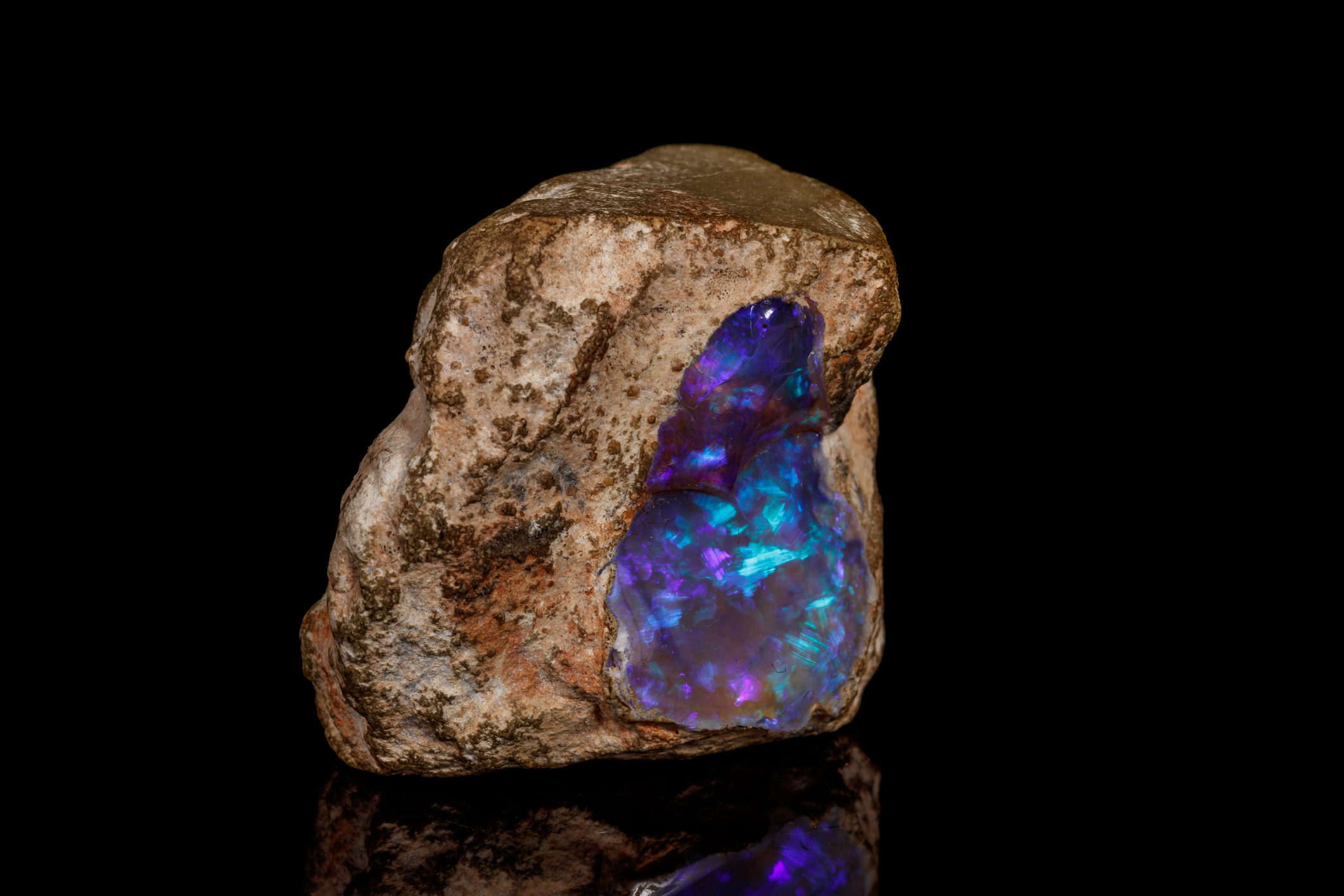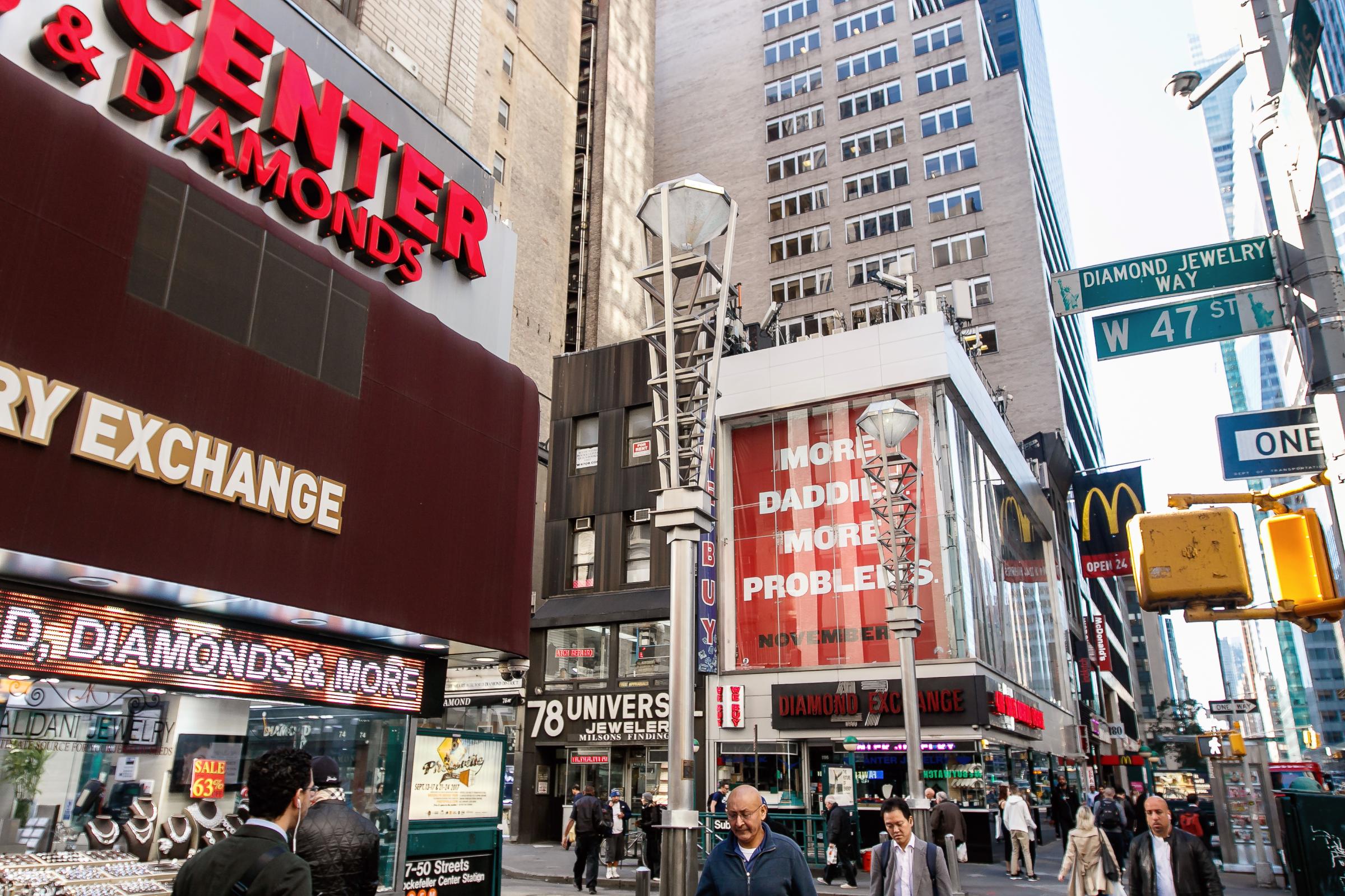Just a few minutes’ walk from the flashing billboards and marquees of New York’s Times Square, the tourist traps give way to a different kind of sparkle and hustle. Nestled on 47th Street between 5th and 6th Avenues, the city’s Diamond District draws locals, visitors and the occasional celebrity looking for deals on the best jewels, and among them move the jewelers and dealers who have made the block a thriving hub for the better part of a century. Although the district is a New York institution, it’s been the subject of an unusual form of attention over the past month: Oscar buzz.
In the 2012-set thriller Uncut Gems, Adam Sandler stars as Howard Ratner, a jeweler who also happens to be a gambling addict desperately trying to pay off his mounting debts. He trades rings, gems and (fake) watches along a path that’s clearly headed toward self-destruction. Directed by brothers Josh and Benny Safdie, who co-wrote the screenplay with Ronald Bronstein, the film has garnered critical acclaim and box office success since its December release. To date, the movie has earned about $37 million, a record for distributor A24, which also released the likes of Moonlight, Lady Bird and Eighth Grade. It won the New York Film Critics Circle Award for Best Director, as well as Best Actor (Sandler), Best Original Screenplay and Top Ten Films awards from the National Board of Review. Though he’s not quite considered a shoo-in for a Best Actor Oscar nomination, Sandler’s name is among a dozen or so regularly discussed as contenders.
But just how true is Uncut Gems to what life is really like on the block? TIME stepped out onto 47th Street to talk to real-life jewelers about how much of what the film depicts is true to their experience, and how much seems like embellishment for drama’s sake.
“A one-to-one” comparison between film and reality
Walk down the block known as Diamond and Jewelry Way, and you may spot familiar faces from the film. Jason “J-Frost” Adams, a jeweler who was one of the many authentic extras cast in the film, says he thought the movie was a “pretty accurate” portrayal of his industry, right down to Kevin Garnett’s starring role as an alternate version of himself, when he was still playing for the Boston Celtics in 2012. “Kevin Love’s our guy,” Adams tells TIME, explaining that the Cleveland Cavaliers all-star player is a client at Greg Yüna Jewelers, where he works.
Ed Yüna, who was not involved in the film but recently saw it in theaters, agrees. “It’s a one-to-one” comparison of the film to real life, he says — including the high-stress deals, the athletes and hip-hop star clientele and even the phony bidding to rack up auction prices. “Typical,” Yüna says of one particular scene, which comes late in the film when Howard is trying to increase the sale price of a rare gemstone. And he says he understands the “principle” that drives one character to commit violence in the film’s final scenes.
One aspect that might be more of a Howard thing? Gambling. Despite the many similarities between the movie’s plot and real life, Michael Awad, a nearly 25-year veteran of the business who owns Awad Jewelry, says that from what he’s seen, gambling isn’t exactly prevalent. “There are some people that gamble, but it’s not a lot. It’s very few,” the owner tells TIME. And though the film paints a dangerous picture, the jeweler says that he doesn’t fear for his own safety. “I feel very safe here on [47th Street]. This block, between 5th Avenue and 6th Avenue, is very safe,” he says.
At one point in the film, it becomes increasingly clear that Demany (Lakeith Stanfield), who brings potential clients to Howard’s business, sells counterfeit watches. Even though that’s always possible when seeking out luxury goods, Awad says he’s seen a “very, very little” amount of fake goods in the Diamond District. According to a March 2019 report from the Organisation for Economic Cooperation and Development and the EU Intellectual Property Office, counterfeit and pirated products make up approximately 3.3% of worldwide trade.
Oh, and about that opal value

An uncut black opal mined in Ethiopia is Howard’s main obsession, but the gemstone he thinks may earn him a million dollars causes more trouble than it’s worth (and it’s not worth nearly that much after all). Yüna and Adams say they agree with the titular gem’s ultimate price point, which is revealed later in the movie.
Doug Hucker, the CEO of the American Gem Trade Association, says it’s entirely possible that a real-life appraiser might have a different estimate than Howard’s.
“When you’re working with gemstones, especially when you’re working with rough gemstones that need to be cut, that requires some considerable expertise to really put a valuation on the piece,” Hucker, who hasn’t seen the film, tells TIME. “You don’t know what’s going to happen when you cut a gem stone.”
While the black opal is highly coveted, that doesn’t necessarily mean it’s rare — many black opals come from Australia and from Ethiopia, according to Hucker. “If it’s big, and it’s fine, and it’s wonderful, and a capable person can see what the recut potential is, it could be worth a million dollars,” he says. “As a general rule, black opal is probably the most valuable and desired of all the opals.”
A decade of research

In an attempt to create an authentic depiction of this one-block universe in New York City, the Safdies spent a decade studying the Diamond District before making the film, and the brothers drew inspiration for Howard’s world from various jewelers on the block. They and Bronstein also drew inspiration from their Jewish upbringings, and from real-life Jewish figures of the 20th century, “overachievers,” as Josh Safdie told Slate, “trying to work their way into society: the Rodney Dangerfields, the Lenny Bruces, the Don Rickles, the Al Goldsteins.”
They grappled with issues of Jewish identity, striving and assimilation. Howard, like many jewelers in the Diamond District, is an observant Jew. “I think what you see in Howard is the long delineation of stereotypes that were forced onto us in the Middle Ages, when the church was created, when Jews were not counted toward population, and their only way in, their only way of accruing status as an individual, as a person who was considered a human being, was through material consumption,” Safdie continued.
During their research in the Diamond District, the Safdies made some friends, including Avianne & Co. owners Izzy Aranbayev and his brother Joe Avianne. Avianne’s son had a minor role in the film, and Aranbayev’s son Jonathan was cast as Howard’s older son. Rapper and actor Cam’ron connected the Avianne crew with the Safdies and Sandler to help with their research ahead of filming, and Sandler shadowed Aranbayev and other employees for a couple of months to learn the trade firsthand.
Jewelers at Avianne & Co., which provided jewelry for Sandler’s character as well as Stanfield’s, say that the flashy celebrity clientele of Howard’s store also checks out. Though Avianne & Co. has an online store and a storefront that’s usually open to the public, it also does a lot of business with celebrities, including the rappers Lil Uzi Vert, Cardi B and Blueface, British soccer player Raheem Sterling and boxer Floyd Mayweather. The store is sometimes closed to the public to allow high-profile customers to browse without disruption from fans.
As for the film’s more intense and violent moments, like one scene in which Howard is locked naked in the trunk of his car, Avianne says those “mobster scenes” don’t really exist in their world — but he isn’t bothered by the portrayal. “It had to be in the movie. You need to have drama. People want to see stuff like that,” he tells TIME. “It had to be done, or else what would be the fun of it?”
Trap doors, trust and “going through the hoops”
At Avianne & Co., in a spacious office behind the showroom — stocked with whiskey and sparkling water and decorated with fantastical artwork depicting the animated characters Mario and Scrooge McDuck wearing bling — Avianne’s eyes keep darting around to look at a huge TV screen mounted to the wall, with nearly a dozen different camera angles of security footage. Naturally, security is always top of mind for a store showcasing millions of dollars worth of diamonds, but things are more tense here ever since a September robbery in which armed thieves reportedly stole around $4 million worth of merchandise.
Security concerns abound in Uncut Gems, as Howard’s store is protected by a double-locked glass vestibule. Avianne says these vestibules, which he calls “trap doors,” are common for similar upper-floor offices in the district.
But in the film, the deals Howard cuts seem to present a more immediate threat to him than his store potentially getting robbed. His most urgent fear is, simply put, getting screwed. Howard’s trouble reaches another peak after he begrudgingly lets Garnett borrow the black opal that he thinks may or may not be worth a million dollars, and he struggles to get the gem back in time for an auction.
“You give someone a product just based on your word,” Avianne says, empathizing with what the character went through to get it back. “[Howard] going through the hoops, and the circumstances he was put in, is real-life sh-t. This is what most people go through here on the block.”
But at the end of the day, Avianne says, trust is a huge part of his industry, and that’s why so many characters in the movie still try to help Howard and honor his promises. “You try to give everyone the benefit of the doubt. In the film, as you can see, the guy tries his absolute best,” he says.
More Must-Reads from TIME
- Caitlin Clark Is TIME's 2024 Athlete of the Year
- Where Trump 2.0 Will Differ From 1.0
- Is Intermittent Fasting Good or Bad for You?
- The 100 Must-Read Books of 2024
- Column: If Optimism Feels Ridiculous Now, Try Hope
- The Future of Climate Action Is Trade Policy
- FX’s Say Nothing Is the Must-Watch Political Thriller of 2024
- Merle Bombardieri Is Helping People Make the Baby Decision
Write to Rachel E. Greenspan at rachel.greenspan@time.com